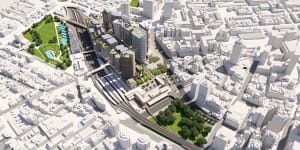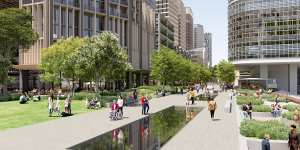Plans for,plazas and a pedestrian avenue separating towers were unveiled on Monday in a draft blueprint for the site at the southern end of the CBD,which is dominated by Australia’s busiest train station.

Premier Dominic Perrottet and Infrastructure,Cities and Active Transport Minister Rob Stokes unveil the draft blueprint for the Central Station precinct on Monday.Oscar Colman
Under the plans,a giant deck will be constructed over the regional and intercity rail lines which terminate at Central,allowing about 15 buildings to emerge above,as well as a pedestrian avenue,laneways and plazas.
Infrastructure and Cities Minister Rob Stokes said the proposal to build the deck over working rail lines to support buildings up to 34 storeys presented a “huge engineering challenge”.
“We’ve only got a 10-year window to do it because the forecast is that these lines are going to become busier,and we will lose the opportunity to deal with that huge operational structure,” he said.
Stokes cast the project as a rare opportunity to heal an urban scar created by the railway separating inner-city suburbs,rejuvenating “forgotten heritage gems” and transforming disused public spaces. “Communities like Chippendale and Surry Hills will be united,” he said.

The proposed redevelopment covers a 24-hectare site at the southern end of Sydney’s CBD.NSW government
University of Sydney transport expert Geoffrey Clifton said building a large multibillion-dollar development atop busy rail lines would be both “very expensive” and an enormous engineering feat.
“This is just about as complicated as engineering gets in the city. There is always the risk of something going wrong or finding something you didn’t realise was there,” he said.
“You also have to make sure you are not limiting options for the rail line.”
The along George Street in the CBD late last decade,which was dogged by repeated delays and cost overruns,serves as a reminder of the challenges.

A pedestrian avenue up to 24 metres wide will be built above existing rail lines leading into Central Station.NSW Government
Clifton said urban developments in and around a station such as Central made economic sense because “you can’t get any closer to public transport than building above a train line”.
“It is a huge engineering feat,but it has a potential to realise a lot of value for the city centre and make use of underutilised real estate,” he said.
More than six hectares will be designated a public domain,almost a third of which is slated for parks,squares and plazas,including two civic spaces known as Central Square and Central Green.
Urban think-tank Committee for Sydney said the plans for the area around Central Station presented an “incredible opportunity but one that will be quite a challenge”.
“The real test is whether they can resolve the public realm issues of such a complicated site ... to make it feel like a nice place to be,” chief executive Gabriel Metcalf said. “Over-station developments are notoriously tricky,and places like the Hudson Yards in New York have achieved only mixed success.”
Labor transport spokeswoman Jo Haylen said the government was already facing delays and cost blowouts on converting part of into one that carries driverless metro trains.
“If they now plan to do major construction that involves at least six existing railway lines then they need to learn from their mistakes,so the public aren’t faced with the same cost blowouts and project delays,” she said.
Our Breaking News Alertwillnotify you of significant breaking news when it happens..